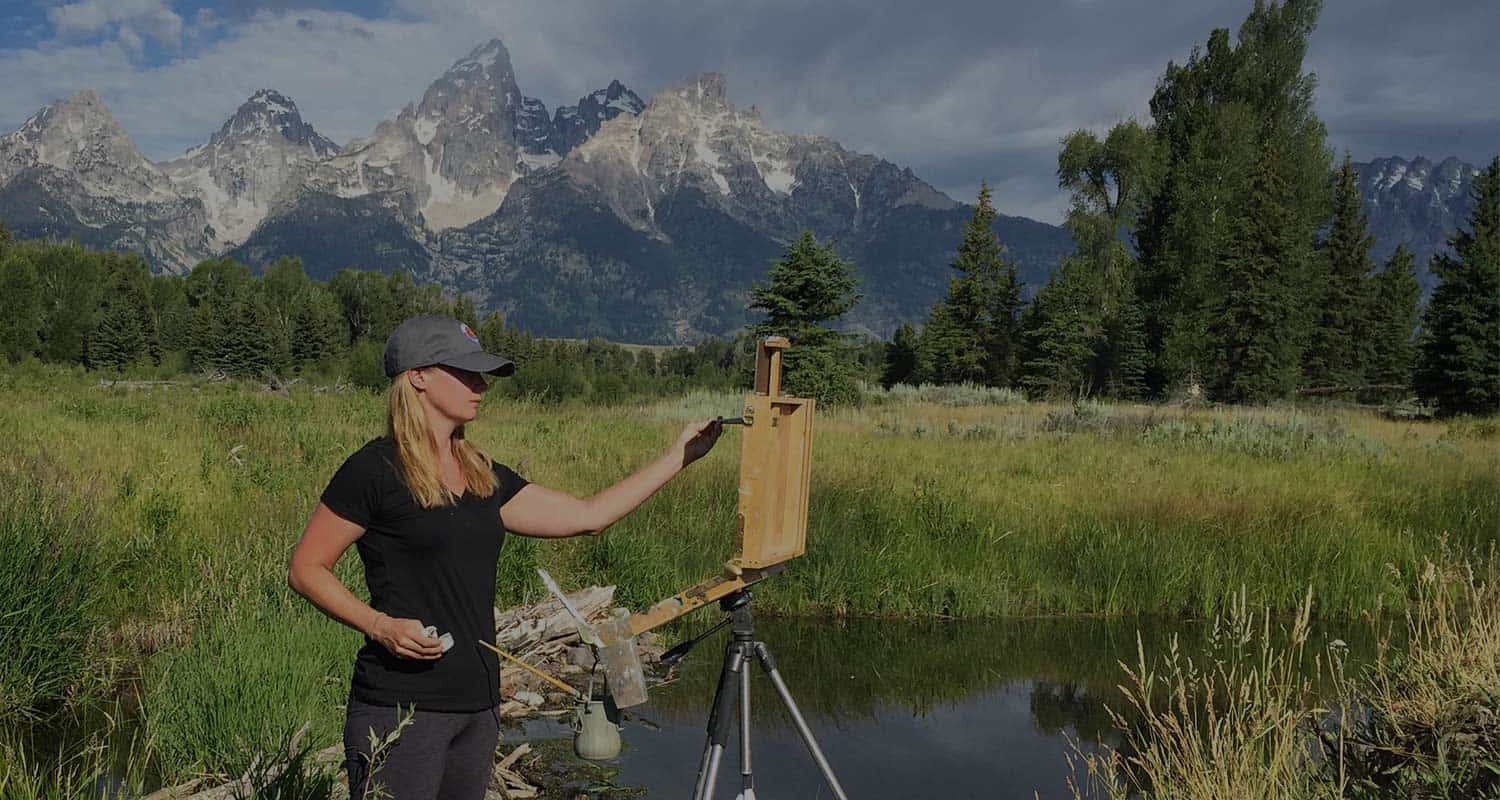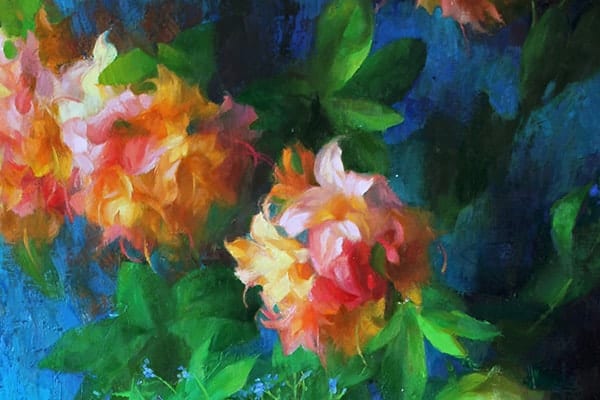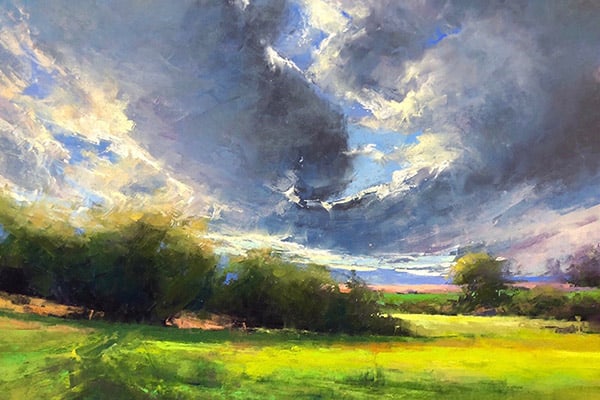Stacey Peterson, Painter
Avid outdoorswoman Stacey Peterson discusses how she’s gone from plein air to the studio without losing the energy of a landscape and what “Stacey Peterson light” really means.
Stacey’s work is now on view at Turner Fine Art in Art That Inspires: A Curated Show of Master Painters, through September 28th.
Where are you from? Where do you live now?
I was born in Salt Lake City, but I have lived in Colorado my whole life. I grew up in the Denver area and now I live in Evergreen, which is just in the mountains. We’ve been up here about 6 years. I don’t see myself moving anytime soon.
How did you become interested in art? When was that?
I have always done art since I was a little child. It’s always kind of been my thing. I always loved drawing and painting. I was pretty serious about art in high school, but my parents did not encourage me to go to art school after graduation. I was honestly the kind of person where I wanted to get a degree, get a secure job, and know I was going to do OK. So I ended up getting an engineering degree and I worked in engineering for 6 years. In that time, I always took painting classes on the side, so it’s always been a part of me. I just didn’t make it my job until 11-12 years ago.
I really feel like people don’t think of engineering as creative, but it’s very much all about problem solving. Having a degree in that and working in that field really prepared me to be a small business owner and for being an artist. There are things I take from those years that I use quite a bit. I am happy with what I did and I am happy that I switched. I think coming to art later, I had a better vision for what I wanted to do.
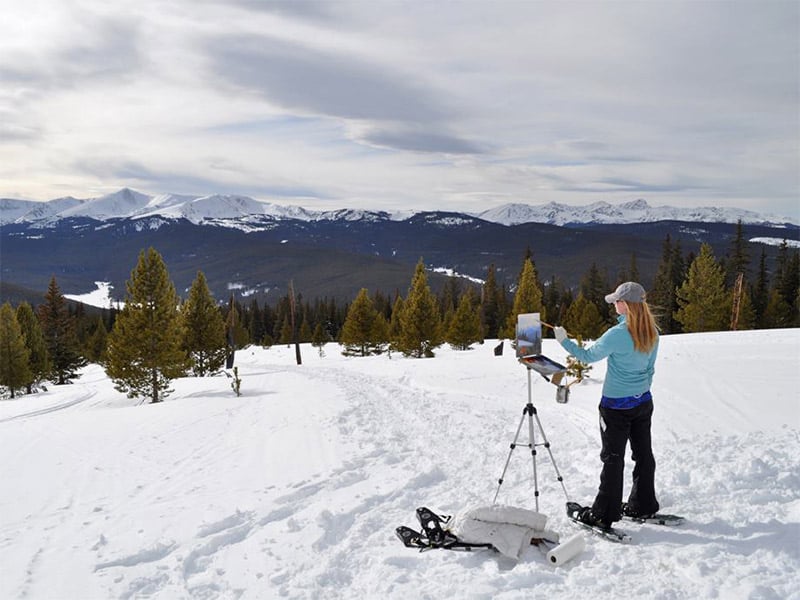
Stacey Peterson painting plein air.
THE EXHIBITION
How would you describe the content of your work for this exhibition?
I was super excited to do a show with studio work in Jackson Hole. I have come up there quite a few summers to the Rocky Mountain Plein Air Painters – so that’s actually how I know Kathryn Turner. So that’s all plein air work when I do that show, but it’s fun to do a show up here of studio work where I get to spend a little more time thinking about what I want to do and do some bigger work. All of my work for this show is new. I love hiking in the Tetons and the landscape – it’s just so inspiring – so I really focused on the area around Jackson.
In your blog post you said, “I had decided that the plein air scene wasn’t where I wanted to be. I wanted to do big studio paintings, and spend more time on my work.” Is that shown in this exhibition?
Yes, definitely. And it’s kind of a different approach. I love plein air painting and as a landscape painter, it’s a really a skill you should have. But that said, you can do a different stuff in the studio than you can plein air. So the first painting I did for this show, it was a long hike to Holly Lake with some painter buddies including Mitch Baird, who’s also in the show, and I just took this picture of the sunset on the mountains. It’s not something I could have painted plein air because it was so quick and I was so far up there and had to get down. So I spent some time in the studio trying to remember how it felt. To me that’s the advantage of the studio work: there are things that are inspiring outside, but you don’t have time to get the feeling while you’re outdoors doing plein air. For instance, a sunset plein air is very hard to get because it’s gone so quickly. So these paintings are ones I wouldn’t have been able to get on location.
In this exhibition, do you have a favorite piece? Why?
That’s the one I was just referring to, Last Glance, Paintbrush Canyon. I went on a huge hike with painting buddies after the Rocky Mountain Plein Air Painters a few years ago and we hiked up to Holly Lake, a 16 mile round trip or something. And we just took pictures and spent the whole day around there. I have done many paintings from that area simply because it really captivated me. I really spent my time on this one trying to get the feeling of the area and of the time of day and really get the emotion in there. This is the one I am most excited about because it’s one of those rare pieces that I got the emotional impact from that scene, that day, and that moment.
There’s always a disconnect with your vision for a painting and what you’re able to achieve. As an artist, I am always trying to make that gap smaller. The problem is when you get better then your vision jumps ahead and you’re behind again, but every once in a while you do a painting where you’re like, “I actually got it this time!”

Last Glance, Paintbrush Canyon
THE ART
What mediums do you work with?
I work in oils and fully on hard panels. I like the texture. I like seeing the artist’s hand in the painting. I like seeing the brushwork to see a bit of the process. Every brush stroke you put down, you can really see. It doesn’t get absorbed in the texture of the panel.
What techniques do you employ to get the results you want?
I have more of an impressionistic style and I like visible brushwork. I like to see the energy in a painting, so I don’t want to smooth everything over and have it be too tight and then lose some of the energy I have when I approach a scene with excitement. My process is all about preserving that energy, so over the years, I tend toward more vibrant colors because I am usually super excited about the landscape and the paint in general. I tend to paint early morning or later afternoon when the light is really saturated – that’s what I get really excited about. I really like that to come through with my color. I have really gotten to the point where I almost fully use really large brushes. I rarely bring out a detail brush or anything small. I like to use big brushes because I think If I can keep my shapes big and keep it loose and impressionistic, then it brings more energy to what I am trying to do.
Painting Demo – Stacey Peterson 1/2018 from Stacey Peterson on Vimeo.
What is the most important tool you use?
One thing that’s become really important to me is using a limited palette with my paint. It’s really helped my simplify my colors and has brought immediacy to my paintings so I’m not messing around with 20 different colors. My choice of colors on my palette is really important. I have about 5 colors, so I know how to with them. They’re super comfortable and there’s a lot of immediacy in the process. I don’t need to waste a lot of time to mix a color.
What pleases you about the process?
The most pleasing part is when I go to do the block in of the big shapes. It’s my first marks and at that point, I am usually really excited about it. Just putting marks down in a basic way, the painting has a lot of energy at that point.
What is most challenging about the process?
The thing that has constantly been the most challenging for me is the point where I have to refine the painting. When I block in, it’s really thin paint. When I refine the painting is when I start putting thick paint down. The biggest challenge is in between those two steps: how do I go to the finished painting without losing the freshness and energy that I had in the block in stage? There’s an urge to make things too detailed. How do I keep it fresh and keep it immediate and not lose the energy that I had at the beginning when I am finishing the painting?
How do you approach your work?
The reason that I paint landscape is because I really love being outdoors. It’s just the thing that makes me feel whole. So my goal as a landscape painter is to bring a little bit of that feeling of being outdoors into a painting. Hopefully it will bring the buyer a feeling of that peace when it’s hanging in their home.
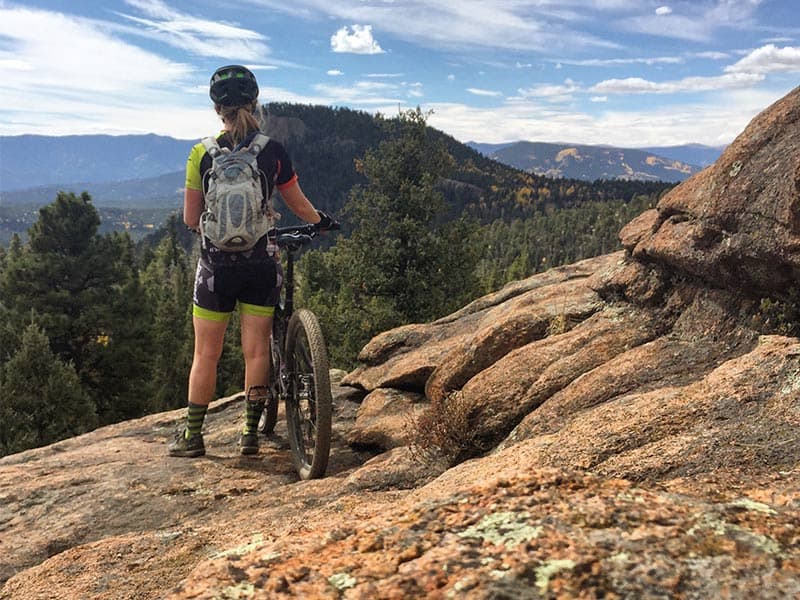
Mountain biking is Stacey’s favorite thing to do besides paint.
How would you describe your aesthetic?
Impressionistic. When I am standing on top of a mountain pass, my first question before I do a painting is to ask what really got me going about a scene. Is it the light on the mountains? Is it the shapes? Is it how big everything seems compared to me? So I try to verbalize what really hit me in the gut. Impressionism is all about these fleeting light effects and things that don’t last that long, and that’s how I define my work because that’s how I approach what I want to do with each painting.
Your work always seems warm and inviting with golden yellow hues. Is this a conscious decision? Are you trying to paint a specific time of day?
I think it’s subconscious. I am aware of it now that I have been doing it, but that’s just the time of the day and the light that I am naturally drawn to. I love playing with the contrast of cold shadows and warm light.
I went on a hut trip with my husband and a bunch of painter friends. One night I went out snowshoeing and I was supposed to be back in 5 minutes but there was beautiful sunset light on the snow. You had all these blue shadows and warm light, so I got all caught up and I was gone 45 minutes! My husband got worried thinking I was supposed to be back soon and one of the artists on the trip said, “Oh, don’t worry. That’s Stacey Peterson light.” Until that time I don’t think I had verbalized or realized that that’s what I react to.
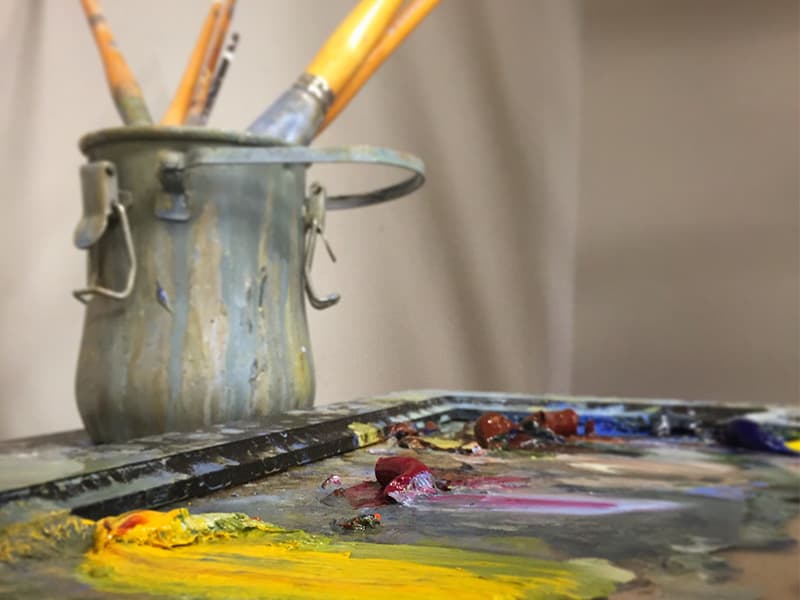
Stacey’s palette.
How does your environment inform your work?
I really think that it’s important as a painter to paint what you know and paint what you love. I live up here in the mountains, it’s what I know. I spend a ton of time mountain biking and hiking and camping with the family, so I know the alpine environment very well and that’s what I paint. I feel very lucky to paint what I love.
How do you carry the feeling from plein air to the studio?
I think the best way for me to get that is to do a small 6×8 fresh color study on location and bring that into the studio, so I have that initial reaction with me. I can’t always do that if I am on my bike or hiking. I do take photos and carry a sketchbook, but if I don’t have that I’ll put notes in my phone about what I am really excited about. I really try to verbalize what I reacted to the at the scene. It’s important before I start a painting and, every once in a while, step back and ask if I am I still working towards that or have I lost sight of it.
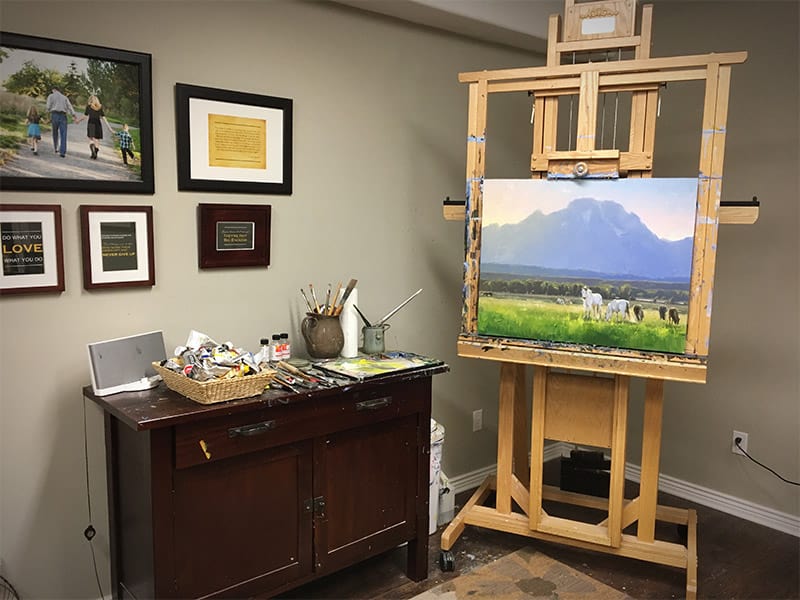
Stacey Peterson’s studio while working on Teton Evening.
THE ARTIST
What subject have you painted the most?
I use to live near Winter Park in Colorado and I have painted Monarch Lake about a zillion times. We used to live up there and we’d go have a picnic with the kids in the evening and walk around, throw rocks in the lake and go swimming. It’s beautiful but it’s also that I spent so much time there that it means so much to me. I know every nook and cranny, the lake and all the trails around it, when the good light hits the mountain, and where all the good views are. That’s a place I spent so much time and I have such a good emotional connection with that I have painted it a ton.
What do you do when you’re stuck on a piece?
I think being able to step away when it’s not working is really important. A lot of times I’ll take the piece upstairs and set it on the mantle in the living room. That way when I am cooking dinner or hanging out with the kids, or going about my everyday business, I’ll be able to glance over at it. All of a sudden what’s wrong with it will be glaring and then I can take it down to the studio and scrape what’s not working and fix it. The biggest thing is just to give myself the space to step away.
What are you currently inspired by (reading, listening, other)?
I like to listen to podcasts on motivation and things, but at this time of year what gets me excited more than anything is that fall is coming. I love being outside this time of year; I drop the kids off at school and go mountain biking in the cool air. I try to paint seasonally. I am definitely inspired by what’s going on around me at any given time.
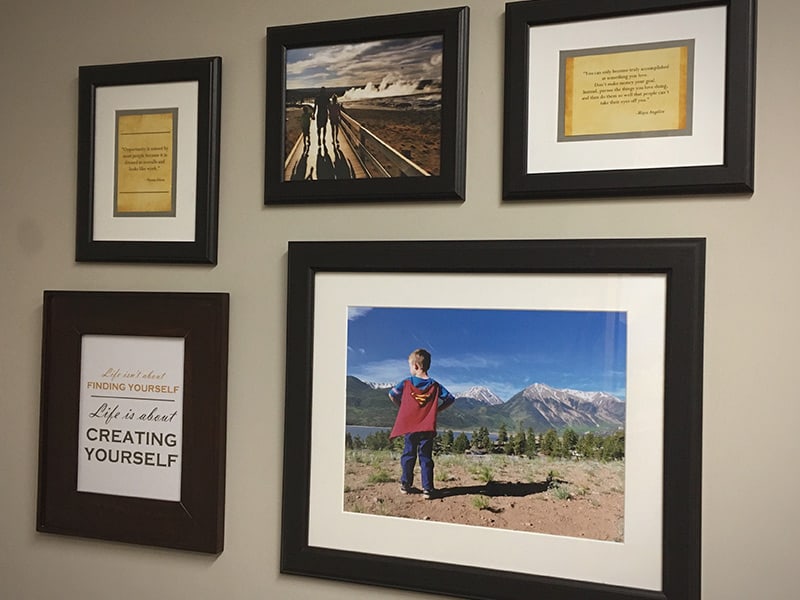
Inspiration inside Stacey’s studio.
What do you do besides your art?
I love spending time with my family, my husband and my two kids that are 11 and 8. They keep me really busy on the mom side. I’m also obsessed with mountain biking. I spend a lot of time on the trail. It’s my favorite thing other than to paint.
What is your favorite destination?
Anything that’s in the mountains is my favorite place to go. A good mountain town where I can go get lost on trails.
What’s your favorite quote?
This quote has motivated me to do things that scare me. So I think about how am I going to decide right now, is it about excuses or experiences?
“What we have is based upon moment-to-moment choices of what we do. In each of those moments, we choose. We either take a risk and move toward what we want, or we play it safe and choose comfort. Most of the people, most of the time, choose comfort. In the end, people either have excuses or experiences; reasons or results; buts or brilliance. They either have what they wanted, or they have a detailed list of all the rational reasons why not.” – Anonymous
This conversation with Stacey Peterson has been edited for brevity and clarity.


